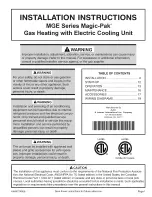
OPERATING YOUR FIRE
The Oxysafe flame sensing and flue blockage safety system.
For your safety, this appliance is fitted with a flue blockage safety device that will shut
down the appliance in the event of abnormal flue conditions.
This device is NOT a
substitute for an independently mounted Carbon Monoxide detector.
The device will also automatically shut off the gas supply to the fire if the pilot flame
goes out due to lack of oxygen or for any other reason.
If this device starts to repeatedly shut off the gas, get expert advice.
This device incorporates a probe that senses that the heat from the pilot flame is correct.
If this probe is cool, the device will prevent any gas flow unless the control knob is held
down at the ignition position.
If, for any reason, the flames go out when the fire is hot or if the fire is turned off when
hot, always
wait at least three minutes before attempting to relight
.
To light the fire.
The control is shown in figure 2.
!
Depress the control knob slightly and turn
anticlockwise towards the 1/IGN position. Do not
apply too much pressure as this will cause
resistance to be felt. Depress the control knob.
Sparks should be generated at the pilot. The sparks
should ignite the pilot. If the pilot does not light,
turn the control knob back to the‘OFF’ position and
try again. The pilot flame can be seen through the
opening immediately below the right hand centre
radiant (See figure 3).
If no sparks are generated at the pilot the battery may have no power. The battery can
be replaced as shown later in this guide.
In the unlikely event of failure of the ignition mechanism or where a replacement
battery is not available the pilot can be lit with a long match or taper – See next page.
Page 6
OWNER GUIDE
PLEASE NOTE
When operating your fire for the first time, some vapours may be given off which may
cause a slight odour and could possibly set off any smoke alarms in the immediate
vicinity. These vapours are quite normal with new appliances. They are totally harmless
and will disappear after a few hours use.
Figure 2.



























